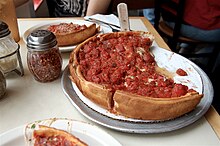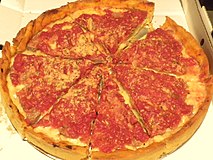Chicago-style pizza
Styles of pizza developed in Chicago, including deep-dish pizza From Wikipedia, the free encyclopedia
Chicago-style pizza is pizza prepared according to several styles developed in Chicago. It can refer to both the well-known deep-dish or stuffed pizzas and the lesser-known thin-crust "tavern-style" pizzas.[1] The pan in which deep-dish pizza is baked gives the pizza its characteristically high edge, which provides ample space for large amounts of cheese and a chunky tomato sauce. Chicago-style deep-dish pizza may be prepared either this way or stuffed. Chicago-style thin-crust pizza dough is rolled for a thinner, crispier crust than other thin-crust styles, and the pizza is cut in squares instead of slices.[2][3][4][5][6][7]
 Chicago-style deep-dish pizza | |
| Type | Pizza |
|---|---|
| Place of origin | United States |
| Region or state | Chicago, Illinois |
| Main ingredients | Pizza dough, tomato sauce, cheese |
Deep-dish
Summarize
Perspective
Chicago-style deep-dish pizza was invented at Pizzeria Uno in Chicago, founded by Ike Sewell and Richard Riccardo in 1943.[8][9][10] Riccardo's original recipe for a pizza cooked in a pie pan or cake tin was published in 1945 and included a dough made with scalded milk, butter, and sugar.[11] The restaurant's cook Alice Mae Redmond later adjusted the recipe to be made with water and olive oil and a "secret dough conditioner" to make it stretch better.[12][13] In the 1960s and '70s the dough ball became larger to cover the full sides of the pan, with a higher fat percentage.[11] Redmond later worked at Gino's East, founded in 1966, where she made a fattier, biscuit-like dough.[9][12]
Uno's original pizza chef Rudy Malnati has also been credited for development of the recipe.[14][15] Rudy's sons Lou and Rudy Jr., who also worked at Pizzeria Uno, later respectively founded Lou Malnati's Pizzeria in 1971 and Pizano's in 1991, both also known for their deep-dish pizzas.[15]
The thick pizza crust, sometimes made with cornmeal for texture,[16] may be parbaked before the toppings are added to give it greater spring. In traditional recipes, the top of the crust is layered with meats and/or vegetables and mozzarella cheese while the sides rise to the top of the pan, and then a layer of crushed tomatoes is ladled over the top and the whole pizza is baked to completion.[17][18] Deep-dish pizza is often eaten with a knife and fork, since its thickness and occasional messiness do not lend themselves to eating with the hands as is often the case for thin-crust pizza.[citation needed]
- Deep-dish pizza
- A deep-dish pizza from Zachary's Pizza in Oakland, California
- Deep-dish pizza from Lou Malnati's
Stuffed pizza

By the mid-1970s, two Chicago chains, Nancy's Pizza, founded by Rocco Palese,[19] and Giordano's Pizzeria, operated by brothers Efren and Joseph Boglio, began experimenting with deep-dish pizza and created the stuffed pizza.[20] Palese based his creation on his mother's recipe for scarcedda, an Italian Easter pie from his hometown of Potenza in Basilicata at the far southern end of the Italian Peninsula, more commonly known in Italy as pizza rustica Lucana.[21][22] The primary differences between a stuffed pizza and a deep dish pizza are that stuffed pizzas are typically deeper, have another layer of dough covering the toppings, and have more cheese than deep dish pizza, while deep dish tends to have more sauce.[23]
Thin-crust or tavern-style pizza
Summarize
Perspective

There is also a style of thin-crust pizza known as "tavern style".[24] Residents of two cities claim to have originated it in the 1940s: Milwaukee[25][26][27] and Chicago.[24][28][29]
This pizza has a crust firm enough to have a noticeable crunch and the slices are cut into squares, as opposed to wedges.[24][30][31] The name "tavern-style" comes from the pizzas originally being served in taverns, often as an enticement to drink alcohol. This origin in taverns is also linked to the pizza's shape, as the square shape of the slices made it possible for taverns that did not have plates to instead set them on napkins.[32]
As of 2013[update], according to Grubhub data and the company Chicago Pizza Tours, thin-crust outsells the more widely known deep-dish style among locals, with GrubHub stating that deep-dish comprises only 9% of its pizza deliveries.[33][34] In response, Technomics food industry researcher Darren Tristano questioned GrubHub's conclusion on the basis of the delivery service's user demographics, saying that its younger users can not afford deep dish pizza, while NPR noted that the data would not include information on two particular deep-dish chains (though with just 20 restaurants in the city of 2.7 million) that are not on GrubHub.[33]
Toppings
The typical toppings commonly found on pizzas in most of North America (such as sausage, pepperoni, onions, and mushrooms) are also standards in Chicago-area pizzerias. A survey in 2013 indicated that while the most popular pizza topping in most of the United States is pepperoni,[35][36] in Chicago the most popular topping is Italian sausage.[37]
See also
Wikimedia Commons has media related to Chicago-style pizzas.
References
Further reading
Wikiwand - on
Seamless Wikipedia browsing. On steroids.


